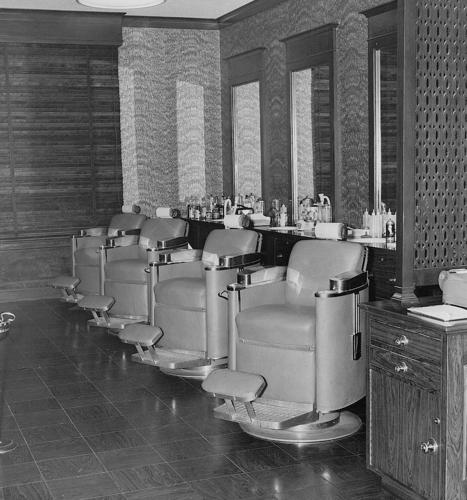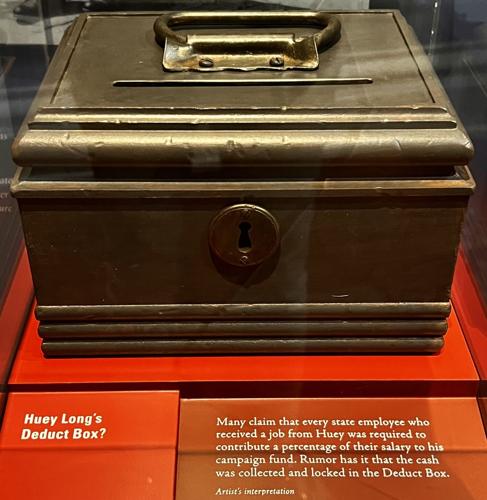Michael Martin has no doubt that if anyone knew the location of Huey P. Long's storied deduct box, it would have been Seymour Weiss.
The deduct box was said to be a locked box where Long kept deductions or "deducts" from state employees' salaries to fund his political operation.
Martin, professor of history and interim head of the Department of History, Geography and Philosophy at the University of Louisiana at Lafayette, notes that Weiss was Long's top confidant, having started out as manager of the Roosevelt Hotel's barbershop.

Seymour Weiss, who owned the hotel from 1934 to 1965, began his career in 1925 as manager of the barber shop, shown here in 1967. ORIGINAL CAPTION Section of ultra restful Roosevelt Barber Shop
The hotel was known back then as the Grunewald, the building's name when it was constructed in 1893 on New Orleans' Central Business District Side of Canal Street. It occupies a city block and holds a special place in the hearts of many New Orleans visitors and residents.
For Weiss, the rise from the hotel's barbershop to owner of the block didn't take long.
This is what perplexed Cyrus Melito of Metairie when reading John Pope's April 2 Curious Louisiana story, "History of New Orleans' Roosevelt Hotel." Pope's story traces the hotel's history and provides insight into the hotel's changes through the years.
"It mentioned how Seymour Weiss, the hotel's barbershop manager, became the general manager and public face of the hotel," Melito said. "It seems to me that such a step from barbershop manager to general manager of such a large organization needs some explanation. Maybe an additional article on how Mr. Weiss accomplished such a huge promotion might be of interest to the reading public."

Left to right: Robert S. Maestri, Earl K. Long, Seymour Weiss and King Strenzke shown at outside event.
Well, Melito is right. The story behind Weiss' rise to riches and power not only needs explaining, but it's also a part of Louisiana history.
Weiss was born in Bunkie on Sept. 13, 1896. He worked as a department store clerk in Alexandria before moving to New Orleans in 1916 to clerk in a shoe store.
Weiss landed the barbershop manager's position at the Grunewald Hotel in 1923, then was promoted to the hotel's assistant manager in 1924 and its manager in 1928.
Weiss met the future governor during his campaign for the 1928 gubernatorial election. Weiss became a strong Long supporter.
Author Richard White said Weiss' association with Long changed the trajectory of the New Orleans businessman's life and fortune.
Weiss would transition from the hotel's general manager to its owner. How?

Talking over old times with Seymour Weiss is big band leader Phil Harris, at piano, who was in town to to play in the annual Heart Fund Gold Benefit Tuesday at Lake Wood Country Club. Weiss was president and owner of the Roosevelt Hotel, and first booked Harris to play in the hotel's Blue Room.
White, who also is the retired dean for the LSU E.J. Ourso College of Business, thoroughly researched Weiss' relationship with Long for his 2009 book, "Kingfish: The Reign of Huey P. Long."
While poring through FBI records, he discovered that Weiss was put in charge of managing a collection of 1,200 Big Chief slot machines that came to Louisiana through New York City Mayor Fiorello Henry La Guardia, for whom the Queens-based airport is named.
"Huey was making a deal with the mafia boss Frank Costello," White said. "Mayor LaGuardia was getting rid of the slot machines in New York City, and Costello wanted to place them somewhere. He decided upon New Orleans."
In 1933, Long went to Long Island to meet with Costello, where the Louisiana-governor-turned-U.S.-senator found himself with a black eye and in the news.
White cites the incident of Long's restroom mishap at the Sand Point nightclub on Long Island as the possible meeting place for Long and the mafia boss.

Roosevelt Hotel
Best Hotel
"The nightclub was very ritzy where all the movie stars, gangsters, politicians and ballplayers hung out," White said. "It was also right next to Costello's home."
In a drunken altercation in a restroom in Sand Point, Long ended up with a black eye. The New York Times published a prominent story on the incident. White believes that Long was there for one of his meetings with Costello.
"He went up to Long Island a couple of times and met with Costello to seal the deal," White said. "And the deal was Huey and his operation had 10% of the take."
Once the slot machines came to New Orleans, Long put Weiss in charge of the operation. White's theory is that Weiss made enough money from the operation to buy the hotel in 1934, which was later renamed the Roosevelt to commemorate President Theodore Roosevelt after his death.
"Think about it," White said. "There's no other way Seymour Weiss could get the money to buy the hotel. He was the assistant manager, but he didn't own it. And he was a poor man before this."
White added that President Franklin D. Roosevelt was investigating Long at the time.

The Roosevelt New Orleans, a Waldorf Astoria Hotel, turned on their holiday lights, Waldorf Wonderland, on Tuesday, November 30, 2021 in downtown New Orleans. New Orleans Saints and Pelicans owner Gayle Benson flipped the ceremonial switch to turn on the festive display. (Photo by Chris Granger | The Times-Picayune | The New Orleans Advocate)
"He wanted to take down Huey Long in the same way he did with Al Capone through the IRS for tax evasion," he said.
But Weiss also was being investigated for tax evasion at this time, which led to an indictment in 1934.
In 1935, Long was assassinated, and all IRS records have since been sealed.
"The charges were dropped, and then later in 1940, after Huey was gone, they indicted him again," White said. "He was convicted and went to federal prison for two years. He was owner of the hotel by that time."
Weiss devoted his time to philanthropic endeavors after his release. He was active in the American Hotel Association and was president of the Louisiana Hotel-Motel and the New Orleans Hotel associations, winning statewide awards for hotel management in 1952 and 1957.
Weiss also was a director of the New Orleans chapter of the American Red Cross, the Chamber of Commerce and the International Trade Mart. Finally, in 1968, Weiss chaired the committee for the 250th anniversary of the founding of New Orleans.

An artist's interpretation of the Deduct Box in Louisiana's Old State Capitol's Huey P. Long exhibit. Many claim that every employee who received a job from Huey P. Long was required to contribute a percentage of his or her salary to his campaign fund. Legend has it that the cash was collected and locked in the Deduct Box, which was never found after Long's death in 1935.
Weiss died Sept. 17, 1969, in Baton Rouge. He is buried in Metairie Cemetery.
As for the deduct box, pronounced "De-duct," legend has it that Weiss probably knew its secret location after Long's death. That is, if there really was a deduct box.
"Seymour Weiss was Huey Long's top confidant from early on until Huey's death," Michael Martin said. "He functioned as Huey's campaign manager and oversaw the financial aspects of Huey's political machine. Huey trusted him in a way that he didn't trust other individuals."
Martin added that Long's political machine didn't always accumulate its funding legally, and because of this, Long knew he shouldn't have actual involvement on the money side.
"Seymour Weiss was a crucial cog in the machine," Martin said. "I'll put it this way: If there was a deduct box, then Seymour Weiss would have been one of the people who knew where it was."








